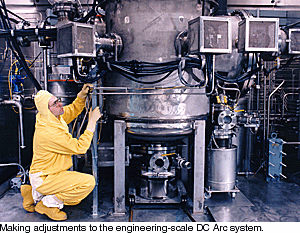


In connection with the Massachusetts Institute of Technology and Electropyrolysis, Inc., Pacific Northwest National Laboratory demonstrated the large-scale, state-of-the-art arc technology on simulated nuclear wastes. Researchers then modified the design to accommodate the semiremote operation necessary for radioactive processing and constructed a system in radioactive facilities in Hanford. The entire program was conducted over a six-year period. Bill Bonner, a principal investigator on the technology with PNNL, states, “We've worked with the DOE sites to design the system and tested it on an engineering scale to produce data that is useful in solving some of DOE's most difficult waste management problems.” A series of nonradioactive and radioactive bench-scale tests were completed at PNNL on Idaho National Engineering and Environmental Laboratory radioactive mixed wastes to determine the potential for using the DC Arc Furnace for that waste treatment application. A second waste stream composed of simulated 238Pu-contaminated job control waste from the Savannah River Site was also successfully tested. These tests helped evaluate the processability of a wide range of feeds and operating conditions before committing to engineering-scale tests. |
 |
Many obsolete, classified, radionuclide-containing weapon components have reached the end of their useful life and need to be disposed of. In engineering-scale testing, the DC arc technology has successfully sanitized radioactive neutron generators. The weapons chosen for the demonstration at PNNL were ferroelectric neutron generators that exist in quantity at DOE's Pantex Plant and contain both hazardous (lead) and radioactive (tritium) constituents. |
| During the test, the DC Arc Furnace changed 200 neutron generators into a form not
recognizable or usable as a weapons component. The technology testing was completed in April 1998, and there are plans to apply the technology to mixed waste from Hanford. Notes Dr. Bonner, “We've been able to integrate our knowledge and experience of radioactive waste treatment with state-of-the-art commercial technology to produce a system for successfully treating DOE wastes. In fact, the program has spawned a thriving small business that is now providing this technology commercially.” For further information, contact Bill Bonner, PNNL, (509) 372-6263. |